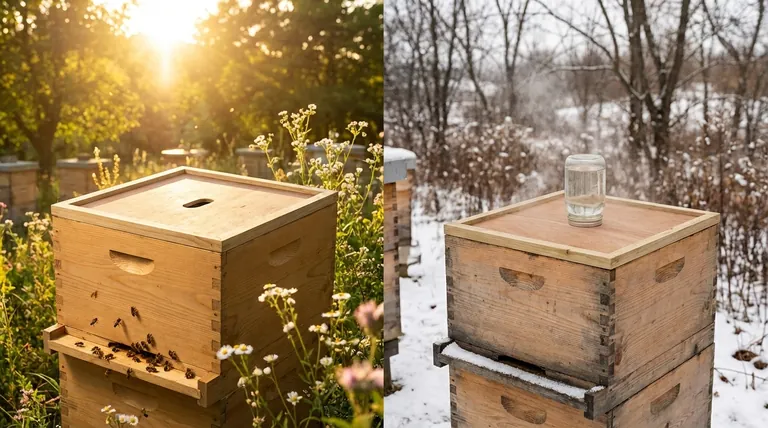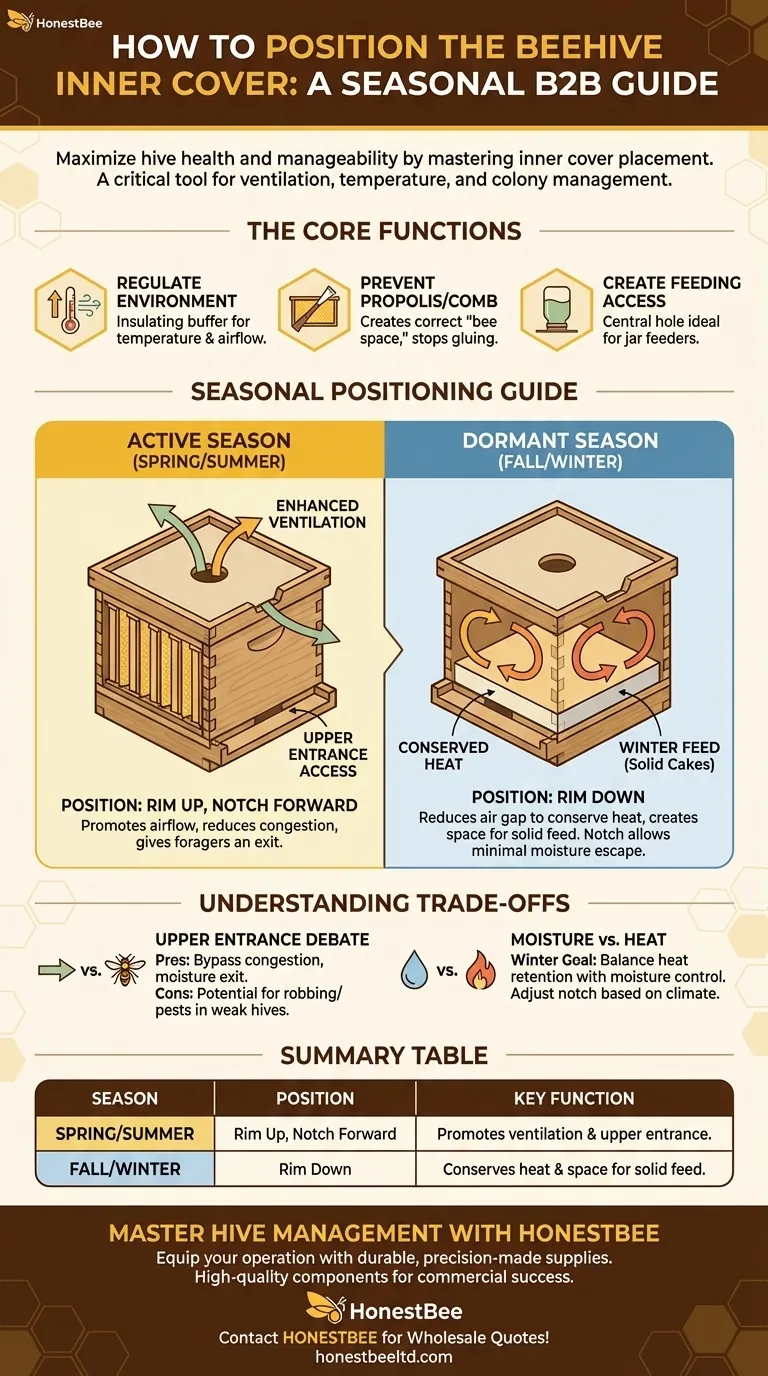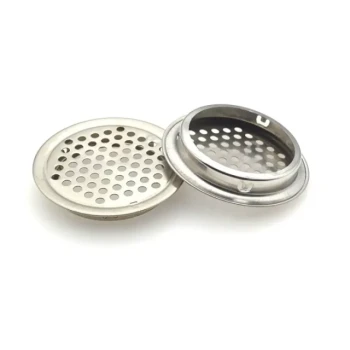For most of the year, the inner cover should be placed directly on top of the uppermost hive box with the deeper rim facing up and the notched entrance facing the front of the hive. This orientation is standard for the active spring and summer seasons.
The inner cover is not merely a secondary lid; it is a critical tool for regulating your hive's internal environment. Its correct placement, which changes with the seasons, directly impacts hive ventilation, temperature control, and your ability to manage the colony effectively.

The Core Functions of the Inner Cover
Before adjusting its position, it is essential to understand why the inner cover exists. It serves several distinct purposes that are vital for a healthy and manageable hive.
Regulating Temperature and Ventilation
The inner cover creates a dead air space between the brood boxes and the outer telescoping cover. This air acts as an insulating buffer, protecting the colony from the intense heat of direct summer sun and the cold surface of the outer cover in winter.
The central hole in the cover allows bees to manage airflow, helping them cool the hive in summer. The small notched rim provides an optional upper entrance, which can improve ventilation and reduce congestion at the main hive entrance.
Preventing Unwanted Comb and Propolis
Without an inner cover, bees would glue the outer cover directly to the top super with propolis and build brace comb in the space. This would make hive inspections incredibly difficult and destructive. The inner cover provides the correct "bee space," discouraging this behavior.
Creating Access for Feeding
The central hole is perfectly designed for placing a jar feeder (an inverted jar of sugar syrup with small holes in the lid). This allows you to feed the colony without fully opening the hive and disturbing the bees.
How to Position the Inner Cover: A Seasonal Guide
The orientation of the inner cover is not static; it should be adjusted based on the time of year and the needs of the colony.
The "Summer" Position: Rim Up
During the warm, active months of spring and summer, the inner cover should be placed rim-side up.
This creates a larger space between the inner and outer covers, enhancing air circulation. Placing the notched opening toward the front of the hive gives the bees a useful upper entrance.
The "Winter" Position: Rim Down
As you prepare the hive for winter, the inner cover should be flipped so the rim-side is down.
This reduces the insulating air gap above the bees, helping to conserve heat. This position also creates a shallow space directly above the frames, which is ideal for placing winter feed like sugar cakes or candy boards. The notch can still provide minimal ventilation to allow excess moisture to escape.
Understanding the Trade-offs
While the inner cover is a standard piece of equipment, its use involves some strategic decisions.
The Upper Entrance Debate
Using the notched rim as an upper entrance is a common but not universal practice. It allows foraging bees to bypass a congested lower entrance and provides an exit point for moisture-laden air.
However, some beekeepers believe a second entrance can make it harder for the colony to defend against pests like wasps or robbing bees, especially in weaker hives.
Moisture vs. Heat Retention
In winter, the primary goal is to balance heat retention with moisture control. A completely sealed-up hive will retain heat but can lead to deadly condensation dripping back onto the cluster.
The rim-down position with the notch open provides a good compromise, but you must monitor your hive's specific conditions. In very cold, dry climates, you might close the notch; in damp climates, ensuring it remains clear is critical.
Making the Right Choice for Your Hive
Your decision on positioning should be driven by the colony's immediate needs and the time of year.
- If your primary focus is active season management: Keep the inner cover rim-up with the notch forward to promote ventilation and provide an upper entrance.
- If your primary focus is preparing for winter: Flip the inner cover to its rim-down position to help conserve heat and create space for solid winter feed.
- If your primary focus is liquid feeding: Use the rim-up position and place an inverted jar feeder over the central hole.
Properly using the inner cover transforms it from a simple piece of wood into a dynamic tool for successful beekeeping.
Summary Table:
| Season | Position | Key Function |
|---|---|---|
| Spring/Summer | Rim Up, Notch Forward | Promotes ventilation and provides an upper entrance. |
| Fall/Winter | Rim Down | Conserves heat and creates space for solid winter feed. |
Master hive management with the right equipment from HONESTBEE.
Properly positioning your inner cover is just one part of successful apiary management. Equip your operation with durable, precision-made beekeeping supplies designed for commercial beekeepers and distributors.
We provide:
- High-Quality Inner Covers & Hive Components built to last.
- Essential Beekeeping Tools & Equipment for efficient colony management.
- Wholesale-Focused Pricing and reliable supply for your business.
Let's strengthen your apiary. Contact HONESTBEE today to discuss your equipment needs and request a wholesale quote!
Visual Guide

Related Products
- Inner Beehive Cover for Beekeeping Bee Hive Inner Cover
- Professional Insulated Winter Hive Wrap for Beekeeping
- Stainless Steel Round Beehive Air Vents for Ventilation
- Professional Galvanized Hive Strap with Secure Locking Buckle for Beekeeping
- HONESTBEE Professional Long Handled Hive Tool with Precision Cutting Blade
People Also Ask
- Why might beekeepers use an inner cover under the telescoping outer cover? Simplify Hive Management & Protect Your Colony
- What is the role of inner covers in insulated beehives? Master Moisture Control for a Healthy Colony
- What are the advantages of using an inner cover in a beehive? Key Benefits for Hive Health & Beekeeper Efficiency
- What is the recommended orientation for the rim of an inner cover? Master Hive Ventilation and Insulation
- How is the inner cover used to promote ventilation? Master Hive Climate Control for Healthy Bees



















